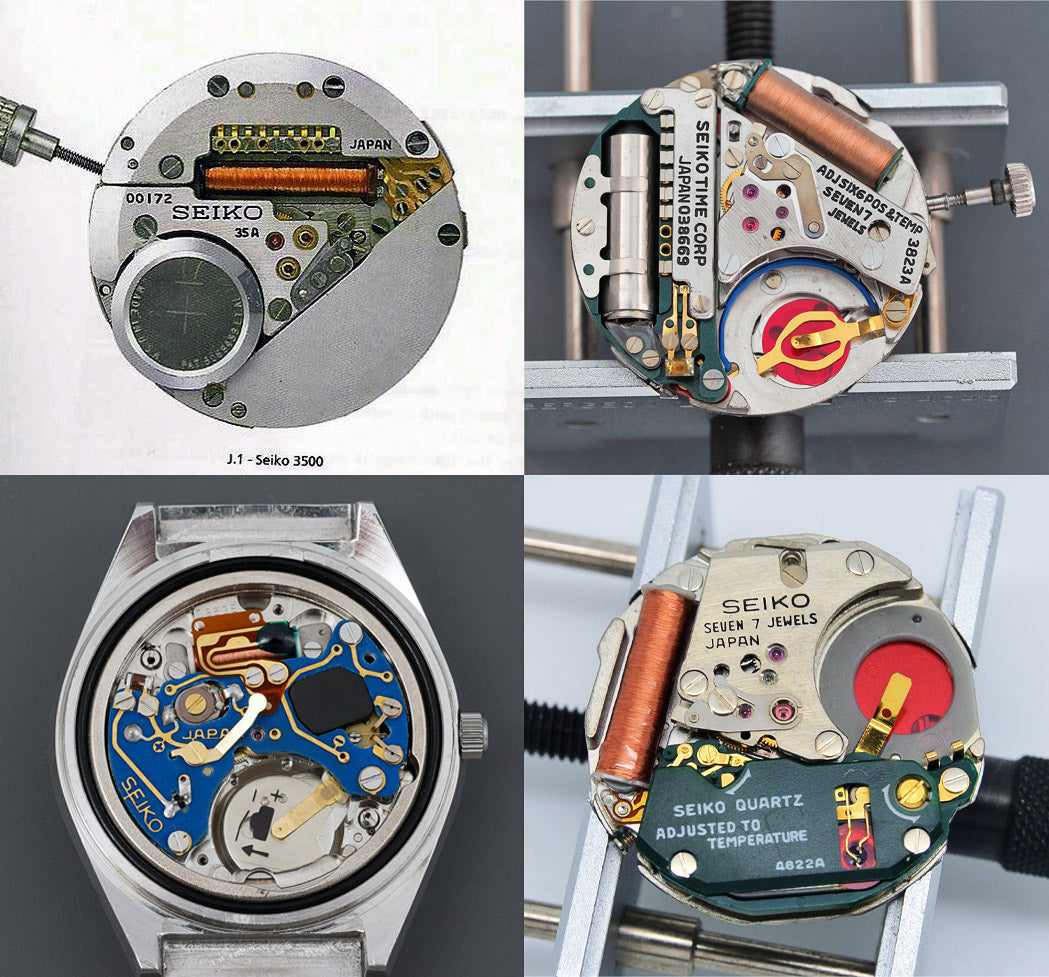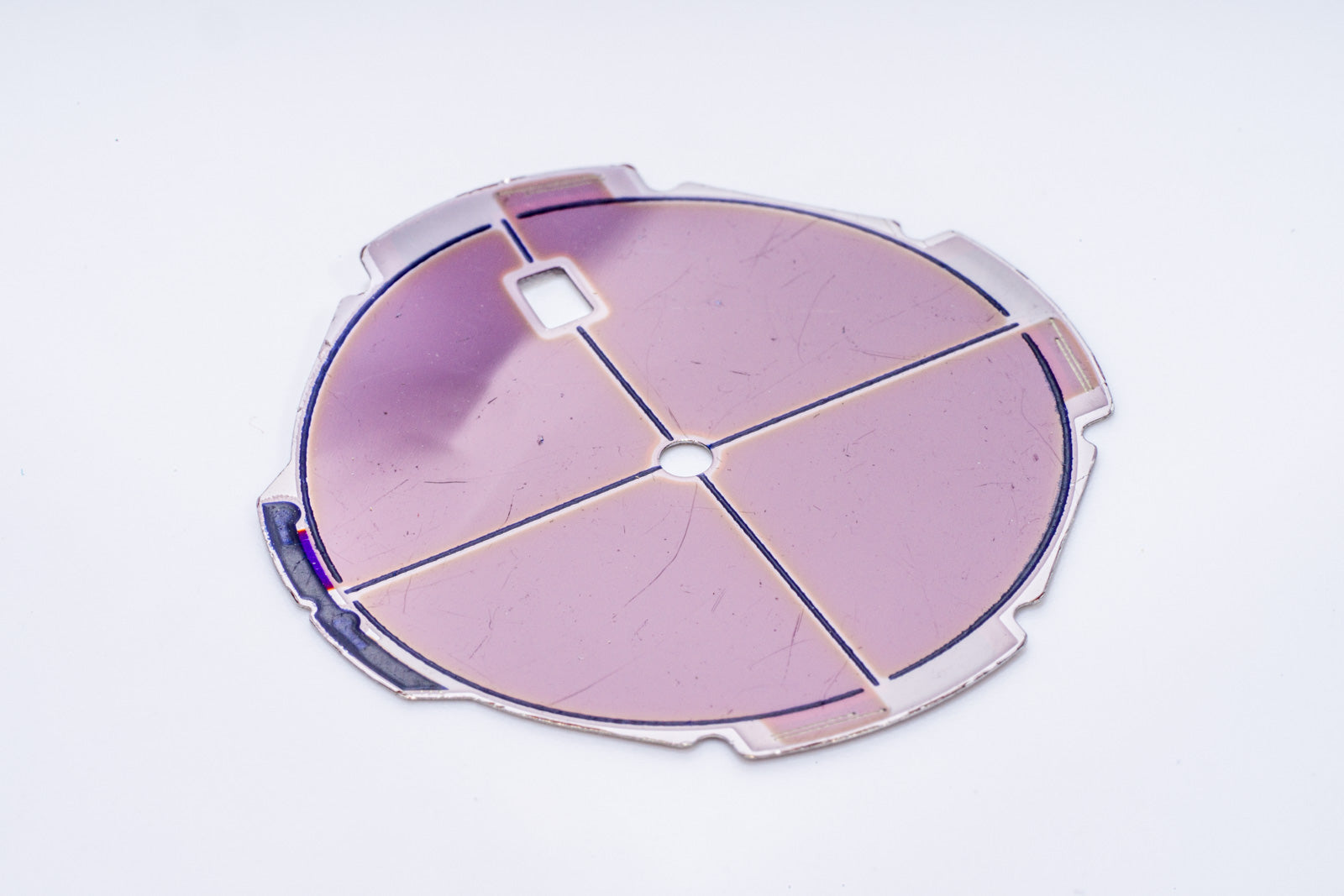
Part 1 - The Beating Heart of Your Watch
A Deep Dive into Battery Movement Mechanics
 Image 1: A Quartz Battery Movement Being Repaired
Image 1: A Quartz Battery Movement Being RepairedYou might admire the aesthetics of a watch - its dial, case, or strap - but the true marvel, the beating heart that brings it to life, lies within: its movement. At Brigade Watch Company, we believe understanding this intricate engine enriches your appreciation for fine horology. Today, let's explore the distinct types of watch movements, peeling back the layers to see exactly how they work, the clever mechanics behind them, and why we chose to use Swiss Automatic Movements, like the renowned ETA 2824-2 and its cousin, the SW200-1, for our timepieces.
There are four primary types of watch movements: Quartz, Solar Quartz, Mechanical - Manual Wind, and Mechanical - Automatic Wind. You might also hear people categorize movements differently-some group Solar-powered watches under Quartz, and others combine Manual and Automatic under a general "Mechanical" umbrella. In general, quartz battery movements are more affordable than their mechanical counterparts. However, it's important to remember that some highly engineered Quartz Battery Movements can actually be more expensive than certain entry-level mechanical ones. Similarly, some Manual Wind Mechanical Movements can even surpass automatics in price, especially when they feature extensive decoration and finishing - their beauty isn't hidden by a rotor, often prompting artisans to put more effort into showcasing their craftsmanship.
 Image 2: The Four Different Types of Watch Movements
Image 2: The Four Different Types of Watch Movements1. Quartz Battery Movement
How it Works: The Magic of a Vibrating Crystal
At the core of every quartz watch is a tiny, often fork-shaped, quartz crystal (a bit like a miniature tuning fork). This crystal has a fascinating and very specific property at its heart, involving something called the piezoelectric effect and its opposite, the inverse piezoelectric effect.
 Image 3: Quartz Crystal
Image 3: Quartz CrystalLet's Break It Down:

Image 4a: Illustrating the piezoelectric effect

Image 4b: Illustrating the inverse piezoelectric effect. Right side is higher voltage.
The Piezoelectric Effect (Direct): This is when certain materials, like quartz, produce a tiny electrical charge when you squeeze or deform them. Imagine a special sponge that, when you squish it, lets out a tiny spark of electricity. That's the piezoelectric effect in action. You might even have used this effect in a gas lighter, where pushing a button squishes a crystal to create a spark.
The Inverse Piezoelectric Effect: This is what the watch uses! It's the opposite: when you send an electric current into the quartz crystal, it vibrates or changes shape ever so slightly. Picture that same special sponge, but now, when you send electricity into it, it starts to twitch or pulse very rapidly and precisely.
Here's how it unfolds inside your watch:
Making the Crystal Vibrate: A battery inside the watch provides a tiny, steady electric current. This current is sent to the quartz crystal. To ensure the quartz's vibrations maintain a super-specific frequency, tiny amounts of gold are often carefully placed or plated onto its surface. This precise amount of gold acts like a finely tuned weight, ensuring the crystal oscillates (vibrates back and forth) at an incredibly consistent frequency-exactly 32,768 times per second. It's vibrating so fast, you can't even see it!

Image 5: Quartz Crystal Diagram with Gold Deposits
Counting the Ticks (with "Flip-Flops"): An integrated circuit (a tiny computer chip) inside the watch is like a super-fast counter. This chip is built with many tiny electronic "switches" called flip-flops. Think of a flip-flop as a very simple light switch that can switch ON or OFF, and it "remembers" its last state. Every time the quartz crystal completes a full vibration cycle, it sends an electrical pulse to the first flip-flop. This first flip-flop takes two pulses to "flip" its state (e.g., from OFF to ON, then to OFF again) and then sends one pulse to the next flip-flop. The second flip-flop then takes two pulses from the first to flip its state and sends one pulse further down the line. This chain of flip-flops acts like a series of dividers, constantly cutting the frequency in half.
From Pulses to Motion: After 15 divisions (because 2^15 = 32,768 VPS), the very last flip-flop in the chain will have received enough pulses from the rapid crystal vibrations to finally send out one single, distinct electrical signal per second. This "one-second" signal is different from the high-frequency vibrations that started the counting.

Image 6: Overview of a Quartz Movement's Components
Moving the Hands: This precisely timed one-second signal is then sent to the stepper motor - consisting of the stator, rotor, and coil. This motor converts the electrical pulse into a small, precise mechanical step.
The Gears Turn: The stepper motor's tiny steps are then transferred through a series of small gears that make the watch's hands (hour, minute, second) move precisely around the dial, telling you the time.

Image 7: General Diagram of a Quartz Movement
Pros and Cons of Quartz Movements:
Pros:
- Exceptional Accuracy: They are incredibly precise, often only losing or gaining a few seconds over an entire month. This makes them highly reliable for everyday timekeeping.
- "Grab-and-Go" Convenience: There's no need to wind them or worry about wearing them constantly; they just keep running accurately until the battery needs replacing.
- Most Affordable: Because their production is highly automated and uses electronic components, they are generally the most accessible type of watch.
Cons:
- Battery Replacement: The battery typically needs to be replaced every 2-5 years, which can be an inconvenience and an additional cost.
- Lacks "Soul" for Purists: For many watch enthusiasts, the electronic nature of quartz movements doesn't carry the same intricate artistry, rich history, or "living" feel as a mechanical watch.
- Lower Resale Value: Generally, quartz watches do not hold their value or appreciate over time compared to many mechanical watches.
- Materials: Often incorporate more plastic or less durable components in their construction, especially in cheaper models.

Image 8: Seiko Quartz Movement
2. Solar Quartz Battery Movement: Powered by Light
 Image 9: Solar Quartz Battery Movement Exploded View
Image 9: Solar Quartz Battery Movement Exploded ViewHow it Works: Capturing Light for Power
A solar quartz watch works much like a regular quartz watch, but it gets its power from light instead of just a battery. The magic starts with a special component called a photovoltaic cell, often hidden discreetly beneath the watch dial.
 Image 10: Photovoltaic Cell of a Solar Quartz Watch
Image 10: Photovoltaic Cell of a Solar Quartz WatchLight Collection & Electron Excitation: When light (which is made of tiny energy packets called photons) hits the photovoltaic cell, these photons carry enough energy to actually "push" and energize the electrons within the cell's special semiconductor materials. Imagine a playground where electrons are usually sitting quietly on swings. When photons (light energy) come along, they give the electrons a big push, knocking them off their swings into a higher, more energetic state.
Creating Positive and Negative Poles: The photovoltaic cell is built with different layers of semiconductor materials (like a P-N junction, though we'll keep it simple). One layer ends up with a "surplus" of these excited, free-moving electrons, making it a negative pole. The other layer, now missing those electrons, has "holes" or spaces, making it a positive pole. This separation of charges is like building up pressure in a water pipe.

Image 11: Diagram of a Solar Cell
Generating Current: This difference between the positive and negative poles creates an electrical charge (voltage), and if there's a path, these excited, free electrons will want to flow from the negative side to the positive side to balance things out. This flow of electrons is an electric current!
Transporting Energy to the Battery: This tiny electric current generated by the photovoltaic cell then flows to a specialized charge control circuit (think of this as a "smart power manager"). This circuit ensures the energy is delivered safely and efficiently to the rechargeable cell (a special type of battery). It's like a smart charger for your phone; it makes sure the battery gets just the right amount of power without being overcharged or damaged. This stored energy keeps the watch running even when it's dark.

Image 11b: Seiko Solar Movement with Rechargeable Battery
The Quartz Process Continues: From this rechargeable cell, power is then supplied to the quartz crystal, integrated circuit, stepper motor, and gears. Following the exact same precise process as a standard quartz battery movement to move the hands.
Pros and Cons of Solar Movements:
Pros:
- High Accuracy: Like standard quartz, they provide very precise timekeeping.
- Eco-Friendly & Low Maintenance: Eliminates the need for frequent battery changes, reducing waste and environmental impact. Many can run for months or even years in complete darkness once fully charged, thanks to their efficient energy storage.
Cons:
- Light Dependency: Requires regular exposure to light to stay charged; prolonged darkness can eventually deplete the power reserve and stop the watch.
- Electronic: Still fundamentally an electronic movement, which means it doesn't offer the mechanical artistry desired by some enthusiasts.
- Potentially Higher Repair Cost: If the rechargeable cell or the photovoltaic cell itself fails, repair can be more complex and expensive, sometimes requiring a complete solar board replacement.
- Potentially Higher Initial Cost: The added technology for light conversion and rechargeable storage makes them slightly more expensive than basic battery-powered quartz watches.

Image 12: Exploded view of a solar watch's internal components
End of Part 1
This concludes the first part of our deep dive into watch movement mechanics! We've explored the fascinating world of Quartz and Solar Quartz movements. To continue learning about Mechanical Manual Wind and Automatic Mechanical movements, including why Brigade Watch Company chooses them, please read Part 2 of this article.







